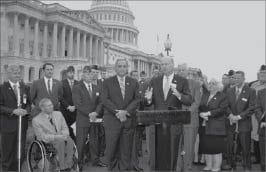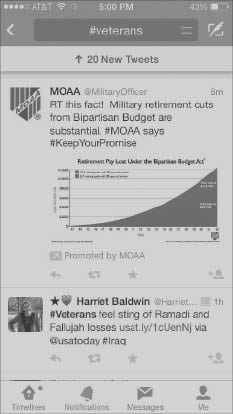Mike Kapetanovic, director of digital at LMO Advertising (LMO), was getting ready to leave his office last Christmas Eve when he got word from his client, the Military Officers Association of America (MOAA). Kathy Partain, director of membership and marketing at MOAA, had just learned that Congress had approved budget cuts to Cost of Living Adjustments (COLA) for military retirees. MOAA, with more than 380,000 members from every branch of the armed services, needed to put together an advocacy campaign in an effort to repeal the cuts. And fast. The budget cuts were scheduled to take effect sometime between January and March.
ALL IN THE TIMING
“Things happened quicker than we thought,” Partain said, referring to putting the campaign together. “But we had a pretty compelling case that military personnel could lose between $69,000 and $87,000 over their lifetime” due to the COLA budget cuts. “For the average military family, that’s a lot of money and that struck a chord.”
The timing of the campaign was able to play into the episodic nature of Twitter, which carries bursts of information in 140 characters or less.
MOAA and LMO agreed that Twitter would be the best PR channel to drive for the effort, leveraging the use of the hashtag #KeepYourPromise.
More specifically, the campaign had two goals:
1. Generate awareness of MOAA’s social channels and improve the reach of MOAA via social content.
2. Get Twitter users to amplify the campaign’s message and take action against the COLA budget cuts.
“There was a huge outpouring from the community, which let Congress know this was not the right time for [COLA] budget cuts or to kick the can down the road,” Partain said.
The Twitter campaign targeted military groups active on the social network, with an emphasis on rallying military spouses and grassroots organizations.

Kapetanovic said the campaign keywords focused on two influencer audiences: Twitter handles involved with U.S. veteran affairs and families of veterans and people who support the U.S. military.
Throughout the second week of this year LMO and MOAA continually fed the Twitter handle with news and information about the budgets cuts, including updates regarding MOAA’s lobbying efforts on Capitol Hill to repeal the cuts.
In order to leverage Twitter, the campaign combined the hashtag #KeepYourPromise with the hashtags #militarybenefits, #militaryperson and #militaryretirements.
“We chose Twitter because it’s news-centric and because of the granularity of targeting,” Kapetanovic said, referring to the paid media component of the campaign.
The paid component was augmented by content designed to generate “earned” media. One message the campaign created for Twitter, for example, featured a link to a graphic showing the deleterious effect that the proposed COLA budget cuts would have on military families.
PRE-COOKED MESSAGES
At the same time—and perhaps more crucial to the outcome of the campaign—MOAA and LMO crafted Twitter posts that drove users to a link where a pre-populated message was available to send to members of the House Committee on Veterans’ Affairs and other members of Congress who are influential in military affairs.

The response to the initial messages helped to inform the subsequent ones. “We used our social listening capabilities to see what MOAA’s audience and other military organizations were saying about the issue, accumulated all that information and that led to the content strategy,” Kapetanovic said.
Partain said there were three things to consider in the executon:
1. Approve the Twitter pre-populated messages quickly but don’t let the grammar suffer.
2. Be ready 24/7 to respond to breaking news from the Hill and tailor the Twitter messages accordingly.
3. Optimize the agency-client relationship in terms of the ability to listen to how the audience responds to the message and find the major influencers in the space who can harness the conversation.
THE RESULTS
Kapetanovic stressed that the onus was on the LMO to maximize every dollar from a $1,000 campaign budget. “We have a fiduciary responsibility to make sure every dollar is used to create engagement,” he said. “We were a lot more selective with the keywords we used so we could hold them to higher standards.”
The PR effort proved decisive, with both the House and Senate in February voting to repeal the cuts to military retirement pay. (The repeal of the budget cuts does not extend to military members who joined the service after Jan. 1, 2014.)
More than 300,000 people forwarded to Congress the campaign message to stop the budget cuts, with 161 people filling out online forms (provided by MOAA) showing they wanted the budget cuts repealed.
The paid media component of the campaign generated 550 retweets, 3,495 clicks and 44 replies. It also had a total engagement of 4,170 people, for an engagement rate of 5.5%.
“Brands and organization don’t need thousands of dollars to generate a solid campaign,” Kapetanovic said. “You need to understand the cause and pick the best [media] platform available. And for time-sensitive, news-centric campaigns, Twitter is the way to go.”
How to Leverage Twitter For Advocacy Campaigns

Our campaign with the Military Officers Association of America (MOAA) taught us a great deal about using Twitter to engage in government advocacy. It taught us that tried-and-true Twitter techniques become all the more crucial and indicative of success when used to persuade the government to act. Here are the top techniques that were crucial to our success:
1. Use Twitter as a consumer insights platform. Working with social listening and intelligence tools allows organizations to monitor relevant conversations, identify influencers and track trends over time. These insights can be used to fuel content strategies, focus audience targeting and identify the best moments for paid campaigns.
2. For advocacy organizations, it’s especially important to drive the most impact when the time is right. The moments when their issues are in the spotlight can be a great opportunity to amplify content with paid tactics. Empowering users with sharable, relevant content when the context is right will drive maximum impact.
3. When attempting to drive users to take specific actions (click to a website or other types of engagement), be sure to focus on one clear call to action. Hashtags and rich media are great in tweets, but make sure the user knows the action you want them to take.
4. Optimize and allocate resources to the content that performs best. One of the great advantages of Twitter is its ability to set up many campaign experiments and very quickly zero in on the segments that are generating the most impact.
5. One recent development organizations may want to test is Twitter’s lead generation cards. Once a user expands your tweet, they can find a call-to-action button that submits their email address in one click.
It’s also important to stay up-to-date on new ad formats (lead cards, TV targeting, etc.). As formats become more sophisticated, brands can target specific audiences and reach the right consumers at the right time.
This sidebar was written by Mike Kapetanovic, director of digital media at LMO Advertising.
CONTACT:
Mike Kapetanovic, [email protected]; Kathy Partain, [email protected].
This article originally appeared in the June 23, 2014 issue of PR News. Read more subscriber-only content by becoming a PR News subscriber today.
